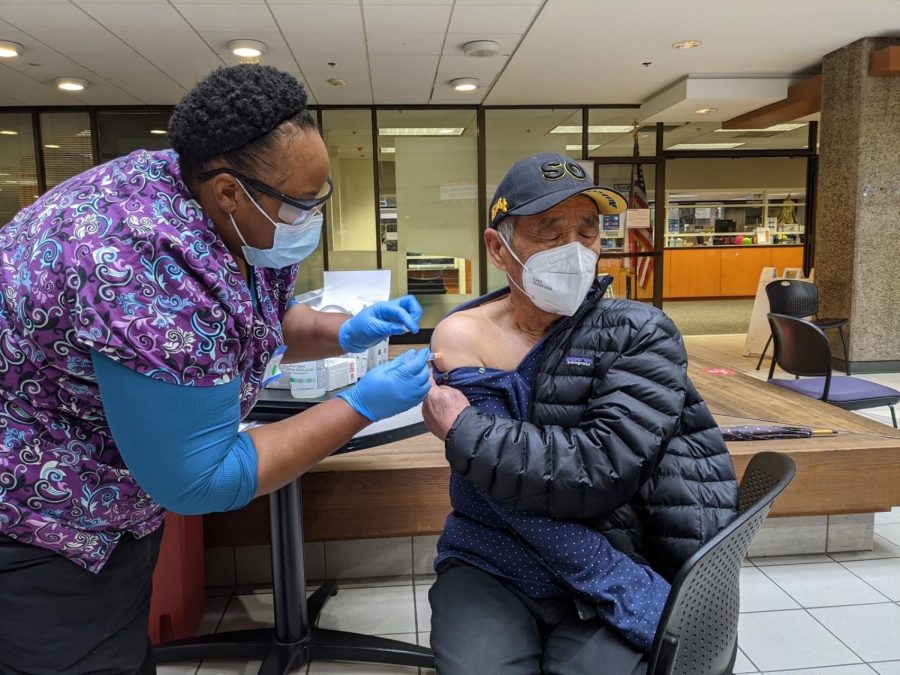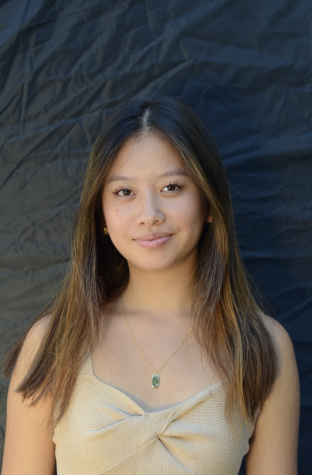Vaccine distributions advance in the U.S., California receives 5.7 million doses
A nurse administers a dose of the Moderna vaccine to Cigeng Zhu, grandfather of Sabrina Zhu (10), at the Santa Clara Valley Medical Center. Those in high-risk groups, including healthcare workers, essential works, and the elderly, are given first priority.
February 1, 2021
After the Pfizer and Moderna vaccines received emergency use authorization (EUA) by the Food and Drug Administration (FDA) in December, COVID-19 vaccinations have been initiated in all states in the U.S. Those in high-risk groups, including healthcare workers, essential works, and the elderly, are given first priority.
A total of 49.9 million doses have been distributed, and 26.0 million people have already received at least the first dose in the country, according to the Centers for Disease Control and Prevention (CDC). These include both the Pfizer vaccine and the Moderna vaccine, which show efficacies of 95% and 94.1%, respectively.
California has received 5.7 million doses and has administered 3.5 million doses, or about 8,740 per 100,000 people. Bay Area counties, including Alameda, Contra Costa, Marin, Napa, San Francisco, San Mateo, Santa Clara, Solano and Sonoma, have administered a total of 752,454 doses.
Alex Baeckler (12), works at a veterinary clinic and was eligible to receive the vaccine as a part of the Phase 1A group, which includes healthcare workers.
“I got the Moderna vaccine, so I’ll be getting my booster 28 days after that. The vaccine itself was honestly pretty painless, they were really fast at giving it [and there was] no pain [after] getting the vaccine. The only side effect I’ve gotten with this one is my arm’s been a little bit sore, but they mostly said that your side effects are going to be more on the second dosage,” said Alex.
“I got my first dose about two weeks ago. I had the Pfizer vaccine. It was a very inconsequential event: [I had] very little soreness in the arm, minor [discomfort] the next day or two, [and it] did not affect movement or mobility. I had no real side effects, no episode of headache or fever or chills. [It was] no different than my reaction to the normal flu vaccine,” Dr. Chung Yen, oral and maxillofacial surgeon and Clinical Assistant Professor at Stanford University and father of Sara Yen (12), said.
Dr. Lee Sanders, Chief of the Division of General Pediatrics and Associate Professor of Pediatrics and Health Policy at Stanford University and father of Zoe Sanders (12), received the Pfizer vaccine and similarly experienced “no major side effects.”
The state continues to prioritize Californians in the Phase 1A priority group, or health care workers and long-term care residents. However, on Jan. 13, Governor Gavin Newsom announced that residents 65 years old or older are eligible to receive the vaccine, lowering the age limit from 75. The CDC’s current goal is to reach herd immunity by vaccinating enough people.
“[Herd immunity] is generally established as more than 70% of the population exhibiting immunity. Immunity can be exhibited by either completing a vaccine schedule or showing serological evidence of immunity, usually through antibody testing,” Dr. Sanders said. “We’re hopeful that we might reach herd immunity by this summer or this fall, but the idea that we will return to normal, that is, pre-pandemic, is probably a little too optimistic.”
On Jan. 4, California also added 36,000 dentists to the list of healthcare professionals cleared to administer the vaccine. There are now over 100,000 professionals able to provide vaccinations in the state. Even with the growing number of certified professionals, the distribution of the vaccine has been difficult.
“The distribution and the efficacy of getting it out to the public has been not great. Clearly, the lack of a national coherent policy on distribution and administration of vaccines was not good,” Dr. Yen said. “Most of the local efforts have been disorganized, and even the distribution of the vaccine along the Bay Area has been very fragmented across counties.”
While the vaccine rollout continues, cases across the country continue to rise. 3.3 million cases and 40,908 deaths have been reported in California. The daily total cases on Jan 31. was 15,358, which is a 0.5% rise from the previous day. 26.0 million people have been infected in the U.S, and the death count is 439,955.
“There is no reason for people to be fearful, as long as they are learning and [adhering] to the recommended mitigation behaviors. This is a very important time to trust the authorities, the public health authorities, and to trust in science,” Dr. Sanders said. “Never did we think that we could develop a vaccine against a fatal disease in less than a year and start to bring it out, so I’m very optimistic about all of those things.”


















![“[Building nerf blasters] became this outlet of creativity for me that hasn't been matched by anything else. The process [of] making a build complete to your desire is such a painstakingly difficult process, but I've had to learn from [the skills needed from] soldering to proper painting. There's so many different options for everything, if you think about it, it exists. The best part is [that] if it doesn't exist, you can build it yourself," Ishaan Parate said.](https://harkeraquila.com/wp-content/uploads/2022/08/DSC_8149-900x604.jpg)




![“When I came into high school, I was ready to be a follower. But DECA was a game changer for me. It helped me overcome my fear of public speaking, and it's played such a major role in who I've become today. To be able to successfully lead a chapter of 150 students, an officer team and be one of the upperclassmen I once really admired is something I'm [really] proud of,” Anvitha Tummala ('21) said.](https://harkeraquila.com/wp-content/uploads/2021/07/Screen-Shot-2021-07-25-at-9.50.05-AM-900x594.png)







![“I think getting up in the morning and having a sense of purpose [is exciting]. I think without a certain amount of drive, life is kind of obsolete and mundane, and I think having that every single day is what makes each day unique and kind of makes life exciting,” Neymika Jain (12) said.](https://harkeraquila.com/wp-content/uploads/2017/06/Screen-Shot-2017-06-03-at-4.54.16-PM.png)








![“My slogan is ‘slow feet, don’t eat, and I’m hungry.’ You need to run fast to get where you are–you aren't going to get those championships if you aren't fast,” Angel Cervantes (12) said. “I want to do well in school on my tests and in track and win championships for my team. I live by that, [and] I can do that anywhere: in the classroom or on the field.”](https://harkeraquila.com/wp-content/uploads/2018/06/DSC5146-900x601.jpg)
![“[Volleyball has] taught me how to fall correctly, and another thing it taught is that you don’t have to be the best at something to be good at it. If you just hit the ball in a smart way, then it still scores points and you’re good at it. You could be a background player and still make a much bigger impact on the team than you would think,” Anya Gert (’20) said.](https://harkeraquila.com/wp-content/uploads/2020/06/AnnaGert_JinTuan_HoHPhotoEdited-600x900.jpeg)

![“I'm not nearly there yet, but [my confidence has] definitely been getting better since I was pretty shy and timid coming into Harker my freshman year. I know that there's a lot of people that are really confident in what they do, and I really admire them. Everyone's so driven and that has really pushed me to kind of try to find my own place in high school and be more confident,” Alyssa Huang (’20) said.](https://harkeraquila.com/wp-content/uploads/2020/06/AlyssaHuang_EmilyChen_HoHPhoto-900x749.jpeg)







